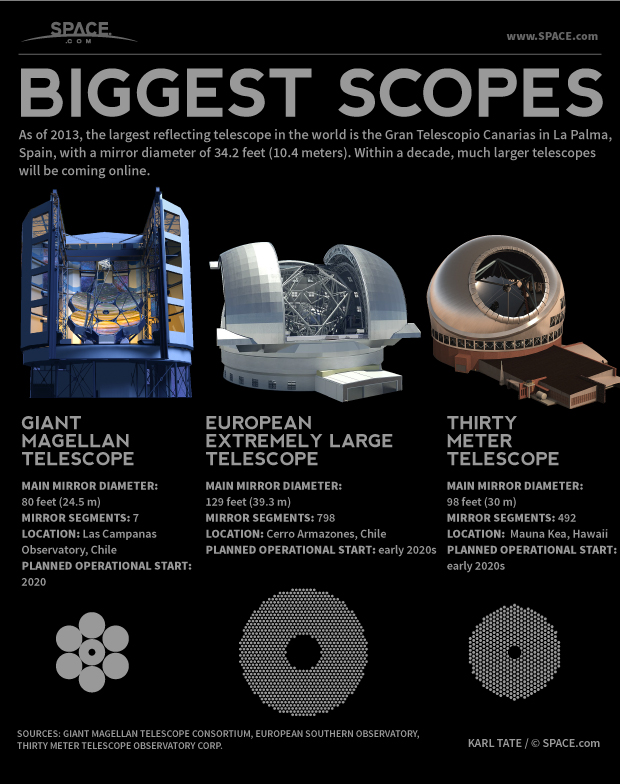New Mega-Telescope Will Soon Rise in Chile's Andes Mountains

A gigantic telescope designed to help astronomers solve some of the universe's deepest mysteries will soon start taking shape atop an arid mountain in the Chilean Andes.
The Giant Magellan Telescope (GMT) completed several major external reviews earlier this year and is on target to enter the construction phase before the end of 2014, project representatives said. If all goes according to plan, the megascope should begin observing the heavens early in the next decade.
"The group here on the project is basically anticipating that we will begin construction activities late this year," GMT director Patrick McCarthy told Space.com. "We're going ahead full steam, aiming for that 2021 first light when the first few mirrors get up on the mountain, along with all the rest of the hardware." [Photos: The Giant Magellan Telescope in Chile]
Scientists will use the enormous telescope to probe the nature of mysterious dark energy and dark matter, find and characterize exoplanets and study how the universe's first stars and galaxies came together, GMT representatives have said.
Building a megascope
The Giant Magellan Telescope will be built on Chile's Las Campanas Peak, at an altitude of about 8,500 feet (2,550 meters). The site was leveled by an excavation blast in March 2012.
GMT will arrange seven 27.6-foot-wide (8.4 m) primary mirrors — the biggest single-piece astronomical mirrors ever made — into one light-collecting surface 80 feet (24 m) across. The completed scope will have 10 times the resolving power of NASA's iconic Hubble Space Telescope, project representatives say.
The GMT design also incorporates seven smaller secondary mirrors, which will change shape to counter the blurring effects of Earth's thick atmosphere.
Breaking space news, the latest updates on rocket launches, skywatching events and more!
Each of GMT's 20-ton primary mirrors must be shaped and smoothed to near perfection. Their surfaces cannot be off by more than 20 nanometers — about the width of a single glass molecule. Adding to the difficulty is the fact that six of the mirrors must be steeply curved, since they surround a central (symmetric) mirror.
Manufacturing and polishing the primary mirrors — activities that are done at the University of Arizona's Steward Observatory Mirror Lab — have proved to be enormously challenging, McCarthy said. But one of the big mirrors is finished, while two others have already been cast. Casting of the fourth one is scheduled for next March. [Photos: Third Mirror Cast for Giant Magellan Telescope]
"So we've dealt with that as our principal technical risk, and we've retired that," McCarthy said.
Fundraising is another challenge. The project's total cost is pegged at $860 million, though perhaps another $100 million will eventually be needed to cover contingencies and the cost of inflation, McCarthy said.
The money will be provided by GMT's many partners, which include educational institutions such as the University of Arizona, Harvard and the University of Chicago, private organizations like the Carnegie Institution for Science and international entities, such as the state of Sao Paulo in Brazil.
Money is now coming in "at a rate that makes us pretty confident that we'll manage to raise enough funds to keep the project on schedule, and that the schedule will be set by the engineering rather than by how fast we can raise money," McCarthy said.
Big scope, big science
GMT should begin science operations in 2021 with four or five of its primary mirrors installed, then get up to full strength the next year, McCarthy said. The telescope's unprecedented light-collecting ability will likely lead to important discoveries in many different areas, he added.
For example, GMT will directly image a wide range of exoplanet systems, yielding insights about faraway and exotic worlds. (Only a handful of alien planets have been imaged to date, and they have all been Jupiter-like gas giants.)
The telescope should allow researchers to probe exoplanet atmospheres, looking for chemical signatures that may have been produced by alien life.
"I'm not saying we'll actually see life on other planets, but we may well see the tracers that are indications of conditions that would support life on other planets," McCarthy said.
Astronomers will also use GMT to peer at distant and ancient objects, getting a look at the universe as it existed just a few hundred million years after the Big Bang— the time when the first stars, galaxies and black holes were forming.
"We want to watch that whole transition, the whole birth of the modern universe," McCarthy said. "GMT will have the collecting area to allow us to do that."
A new generation of telescopes
GMT isn't the only huge ground-based telescope that will begin operations in the next decade. The Thirty Meter Telescope (TMT) is scheduled to start observing from Hawaii's Mauna Kea volcano in 2022, while first light for the European Extremely Large Telescope (E-ELT) in Chile is slated for 2024.
TMT and E-ELT have mirrors measuring 98 feet (30 m) and 128 feet (39 m) across, respectively. Both of these scopes' mirrors will consist of hundreds of relatively small segments, as opposed to GMT's handful of large segments.
All three megascopes are targeting some of the biggest unanswered questions in astronomy. The scientists using them could make transformative discoveries, much as Galileo did when he first pointed his telescope skyward more than 400 years ago, McCarthy said.
Galileo "figured out what the solar system really is, and that is a solar system, not an Earth system. What we're doing now with the large telescopes is understanding what the Milky Way is like and what the universe is like, on a whole different scale," he said.
"In particular, now with the GMT and things like it, we've kind of come back full circle, in that we can do what Galileo did for our solar system for other solar systems — we'll look at other planets around other stars," McCarthy added. "And I think that leap is huge, a landmark thing for this species — to actually be able to take that question 'Are we alone?' and make it a scientific question."
Follow Mike Wall on Twitter @michaeldwall and Google+. Follow us @Spacedotcom, Facebook or Google+. Originally published on Space.com.

Michael Wall is a Senior Space Writer with Space.com and joined the team in 2010. He primarily covers exoplanets, spaceflight and military space, but has been known to dabble in the space art beat. His book about the search for alien life, "Out There," was published on Nov. 13, 2018. Before becoming a science writer, Michael worked as a herpetologist and wildlife biologist. He has a Ph.D. in evolutionary biology from the University of Sydney, Australia, a bachelor's degree from the University of Arizona, and a graduate certificate in science writing from the University of California, Santa Cruz. To find out what his latest project is, you can follow Michael on Twitter.


